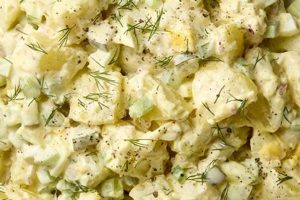This dish typically combines the nutritional powerhouses of kale and sweet potato with complementary ingredients. Roasted sweet potatoes offer sweetness and a creamy texture, while kale provides earthy notes and a hearty base. A variety of additional components, such as dried cranberries, toasted nuts, or crumbled cheese, can enhance the flavor profile and add textural complexity. A vibrant dressing, often vinaigrette-based, ties the ingredients together.
Such salads offer a balanced and nutritious meal option, providing vitamins, minerals, and fiber. The combination of complex carbohydrates, healthy fats, and plant-based protein makes this type of salad a satisfying and energizing choice. Variations can be tailored to accommodate different dietary needs and preferences, from vegan and gluten-free to specific flavor profiles. The adaptability of this culinary concept allows for seasonal adjustments and creative exploration with ingredients.
This discussion will further explore various aspects of creating these salads, covering ingredient selection, preparation techniques, dressing options, and serving suggestions. Nutritional information and potential health benefits will also be examined.
Tips for a Delicious Kale and Sweet Potato Salad
Creating a flavorful and balanced salad involves careful consideration of ingredients and preparation techniques. The following tips offer guidance for achieving optimal results.
Tip 1: Massaging Kale: Massaging kale leaves with a small amount of olive oil and lemon juice or vinegar tenderizes the leaves and reduces bitterness.
Tip 2: Roasting Sweet Potatoes: Roasting sweet potatoes enhances their natural sweetness and creates a soft, creamy texture. Cubing them evenly ensures consistent cooking.
Tip 3: Balancing Flavors: Consider incorporating contrasting flavors and textures. Toasted nuts or seeds provide crunch, while dried cranberries or chopped apples offer sweetness and chewiness.
Tip 4: Dressing Selection: A well-chosen dressing complements the other ingredients without overpowering them. A light vinaigrette with citrus or maple syrup is often a suitable choice.
Tip 5: Adding Protein: Boost the protein content by including cooked quinoa, chickpeas, or crumbled feta cheese.
Tip 6: Seasoning Appropriately: Seasoning with salt, pepper, and other spices enhances the overall flavor profile. Consider spices like cumin, coriander, or smoked paprika.
Tip 7: Proper Storage: Store leftover salad in an airtight container in the refrigerator for up to three days. The kale may absorb some of the dressing over time, so additional dressing might be needed before serving.
By following these tips, one can create a nutritious and satisfying salad that showcases the versatility of kale and sweet potato.
The following section will delve into specific recipe variations and offer further guidance on customization and serving suggestions.
1. Ingredient Quality
Ingredient quality significantly impacts the overall flavor, nutritional value, and textural appeal of a kale and sweet potato salad. Selecting fresh, high-quality ingredients elevates the dish from simple to exceptional.
- Freshness of Produce:
Kale should exhibit vibrant color and crispness, free from wilting or discoloration. Sweet potatoes should be firm with smooth skin, avoiding any soft spots or signs of sprouting. Fresh produce contributes optimal flavor and nutritional content. Using subpar ingredients compromises the salad’s taste and overall quality.
- Sourcing Ingredients:
Locally sourced, seasonal produce often offers superior flavor and supports sustainable agriculture. Farmers’ markets provide access to fresh, high-quality ingredients, allowing for direct interaction with growers and a deeper understanding of ingredient origins. Sourcing ingredients thoughtfully enhances the connection between the consumer and the food system.
- Variety Selection:
Different varieties of kale and sweet potatoes offer unique flavor profiles and textures. Lacinato kale provides a robust, slightly bitter flavor, while Tuscan kale is more tender and subtly sweet. Garnet sweet potatoes have a dense, sweet flesh, whereas Japanese sweet potatoes offer a drier, nuttier flavor. Exploring different varieties allows for culinary creativity and personalized flavor combinations.
- Complementary Ingredients:
The quality of additional ingredients, such as nuts, seeds, dried fruits, or cheeses, equally influences the final result. Opting for high-quality add-ins enhances flavor, texture, and nutritional value. For example, using freshly toasted nuts instead of pre-packaged, stale nuts adds a significant layer of flavor and crunch.
Prioritizing ingredient quality ensures a flavorful, nutritious, and visually appealing salad. The careful selection of each component contributes to a more satisfying and enjoyable culinary experience, showcasing the inherent flavors of kale and sweet potato while maximizing the nutritional benefits. This attention to detail elevates the salad from a simple side dish to a flavorful centerpiece.
2. Preparation Methods
Preparation methods significantly influence the final taste, texture, and overall quality of a kale and sweet potato salad. Proper techniques maximize the flavor potential of each ingredient and contribute to a more enjoyable culinary experience. Careful attention to these methods ensures a balanced and appealing final product.
- Kale Preparation:
Kale’s inherent texture, sometimes perceived as tough or fibrous, benefits from specific preparation techniques. Massaging the leaves with olive oil and a touch of acid, such as lemon juice or vinegar, tenderizes the kale, making it more palatable and reducing any bitterness. This process also helps the leaves absorb the dressing more effectively, enhancing flavor distribution. Chopping or tearing the kale into bite-sized pieces further improves the eating experience.
- Sweet Potato Preparation:
Roasting sweet potatoes brings out their natural sweetness and creates a soft, creamy texture that complements the kale. Cubing the sweet potatoes into uniform sizes ensures even cooking. Alternative methods include steaming or boiling, though roasting generally yields the most desirable flavor and texture profile. Pre-cooking ensures the sweet potatoes are tender and ready to incorporate into the salad.
- Ingredient Combination:
The order and method of combining ingredients impacts the overall balance and flavor of the salad. Adding the dressing too early can make the kale wilt excessively. Incorporating ingredients at the optimal time preserves their texture and prevents over-saturation. For example, adding delicate components like toasted nuts or dried cranberries just before serving maintains their crunch and prevents them from becoming soggy.
- Dressing Emulsification:
Proper emulsification of the dressing ensures that the oil and acid components combine effectively, creating a smooth and cohesive texture. This enhances flavor distribution and prevents the dressing from separating. A well-emulsified dressing coats the salad ingredients evenly, maximizing flavor impact and preventing a watery or oily final product. Techniques like whisking or blending contribute to a stable and flavorful dressing.
These preparation methods, executed thoughtfully, contribute significantly to the overall success of a kale and sweet potato salad. By understanding the nuances of each step, one can elevate the dish from a simple combination of ingredients to a carefully constructed and flavorful culinary creation. Attention to these details ensures a balanced, texturally appealing, and ultimately satisfying salad.
3. Flavor Combinations
Flavor combinations play a crucial role in creating a balanced and palatable kale and sweet potato salad. The inherent flavors of kale and sweet potatoearthy, slightly bitter, and subtly sweet, respectivelyprovide a versatile foundation for a wide range of complementary ingredients and flavor profiles. Strategic combinations elevate the salad beyond basic nutrition to a more complex and enjoyable culinary experience.
- Sweet and Savory Balance:
Balancing sweet and savory elements is essential for a well-rounded flavor profile. The natural sweetness of roasted sweet potatoes can be further enhanced with ingredients like dried cranberries, chopped dates, or a touch of maple syrup in the dressing. Savory notes can be introduced through toasted nuts, crumbled cheese, or savory spices like cumin or smoked paprika. The interplay of these contrasting flavors creates a dynamic and satisfying taste experience.
- Acidity and Brightness:
Acidity plays a vital role in brightening the flavors and cutting through the richness of the sweet potatoes. Citrus elements, such as lemon or orange zest and juice, add a refreshing tang. Vinegar, particularly apple cider vinegar or balsamic vinegar, contributes sharpness and complexity. A touch of acidity balances the sweetness and prevents the salad from feeling heavy or overly rich.
- Textural Contrast:
Texture considerations are as important as flavor combinations. The soft, creamy texture of roasted sweet potatoes contrasts with the slightly chewy texture of kale. Adding crunchy elements, such as toasted nuts, seeds, or croutons, introduces another layer of textural complexity, making the salad more engaging and enjoyable to eat. This interplay of textures elevates the overall sensory experience.
- Spice and Aromatic Complexity:
Spices and aromatics add depth and complexity to the flavor profile. Warm spices like cumin, coriander, and ginger complement the sweetness of the sweet potatoes. Fresh herbs, such as parsley, cilantro, or mint, introduce brightness and freshness. Aromatic ingredients, like garlic and shallots, add pungent notes that enhance the overall flavor experience. Strategic use of spices and aromatics elevates the salad beyond simple flavors to a more nuanced and sophisticated culinary creation.
Thoughtful consideration of flavor combinations elevates a kale and sweet potato salad from a basic combination of ingredients to a well-balanced and flavorful dish. The interplay of sweet, savory, acidic, textural, and aromatic elements creates a symphony of flavors that enhance the inherent qualities of kale and sweet potato, resulting in a truly satisfying and memorable culinary experience.
4. Nutritional Balance
Nutritional balance is a crucial consideration when crafting a kale and sweet potato salad recipe. This dish offers an opportunity to combine nutrient-rich ingredients into a meal that supports overall well-being. Understanding the nutritional contributions of key components allows for informed choices that maximize health benefits.
- Micronutrients from Kale:
Kale contributes significant amounts of vitamins A, C, and K. Vitamin A supports vision and immune function, vitamin C acts as an antioxidant and boosts collagen production, and vitamin K is essential for blood clotting and bone health. These micronutrients contribute to overall health and well-being, making kale a valuable addition to the salad.
- Complex Carbohydrates and Fiber from Sweet Potato:
Sweet potatoes provide complex carbohydrates, which offer sustained energy release, and dietary fiber, which promotes digestive health and helps regulate blood sugar levels. Fiber also contributes to feelings of satiety, aiding in weight management. These components make sweet potatoes a valuable source of energy and support digestive well-being.
- Healthy Fats from Dressing and Add-ins:
Incorporating healthy fats through the dressing or add-ins like nuts and seeds enhances nutrient absorption and contributes to satiety. These fats provide essential fatty acids, which support brain function and cardiovascular health. Choosing healthy fats, such as olive oil, avocado oil, or nuts and seeds, maximizes the nutritional benefits of the salad.
- Protein Considerations:
While kale and sweet potatoes offer some protein, adding a protein source like chickpeas, lentils, or grilled chicken or fish creates a more complete and balanced meal. Protein supports muscle growth and repair, and contributes to feelings of fullness, aiding in appetite regulation. Including a protein source enhances the nutritional profile and promotes overall satiety.
Careful consideration of nutritional balance elevates the kale and sweet potato salad from a simple side dish to a nutrient-dense meal that supports optimal health. Combining the diverse nutritional benefits of kale, sweet potatoes, healthy fats, and protein creates a synergistic effect, maximizing the overall nutritional value of the salad. This approach supports a holistic approach to well-being, incorporating a variety of essential nutrients into a single, delicious, and satisfying meal.
5. Serving Suggestions
Serving suggestions enhance the versatility and enjoyment of a kale and sweet potato salad recipe. These suggestions extend beyond mere presentation to encompass considerations of complementary flavors, textural contrasts, nutritional enhancements, and adaptability to various dietary needs and preferences. Thoughtful serving suggestions transform a basic salad into a customizable and satisfying meal.
Consider a kale and sweet potato salad with roasted pecans and a maple-Dijon vinaigrette. Serving it alongside grilled chicken or fish elevates the dish into a complete protein-rich meal. Alternatively, offering a dollop of plain Greek yogurt adds a creamy element and boosts protein content for a lighter yet satisfying option. For vegan diets, substituting toasted sunflower seeds for pecans and using a tahini-based dressing maintains the flavor profile while adhering to dietary restrictions. These examples demonstrate how serving suggestions tailor the dish to individual preferences and dietary needs.
Serving suggestions offer practical solutions for maximizing flavor and nutritional value. They also provide guidance on incorporating the salad into different meal structures, from light lunches to hearty dinners. Understanding these suggestions allows for greater adaptability and customization, ultimately enhancing the enjoyment and practicality of a kale and sweet potato salad recipe.
Frequently Asked Questions
This section addresses common inquiries regarding kale and sweet potato salad recipes, offering practical solutions and clarifying potential uncertainties. The following questions and answers provide valuable insights for optimizing preparation techniques and achieving desired results.
Question 1: How can bitterness in kale be mitigated?
Massaging kale leaves with olive oil and a mild acid like lemon juice or vinegar helps break down the cell structure, reducing bitterness and enhancing palatability.
Question 2: What is the best method for preparing sweet potatoes for the salad?
Roasting sweet potatoes intensifies their natural sweetness and yields a desirable creamy texture. Cubing them evenly ensures consistent cooking.
Question 3: Can this salad be prepared in advance?
While the salad can be assembled a few hours in advance, adding the dressing immediately before serving prevents the kale from becoming soggy and maintains the crunch of other components.
Question 4: What are suitable protein additions for a more complete meal?
Grilled chicken or fish, chickpeas, lentils, or crumbled feta cheese complement the salad and provide additional protein content.
Question 5: How can the salad be adapted for vegan diets?
Substituting a tahini-based dressing and omitting cheese creates a vegan-friendly version. Maple syrup or agave nectar can replace honey if used in the original recipe.
Question 6: How should leftover salad be stored?
Store leftover salad in an airtight container in the refrigerator for up to three days. Additional dressing may be needed before serving as the kale tends to absorb the dressing over time.
Understanding these frequently asked questions equips individuals with the knowledge to prepare and enjoy a flavorful and nutritious kale and sweet potato salad. These insights contribute to a successful culinary experience and encourage exploration of recipe variations based on individual preferences.
The following section will explore specific recipe variations and provide step-by-step instructions for creating diverse and delicious kale and sweet potato salads.
Conclusion
Exploration of this culinary concept reveals its adaptability and nutritional value. Careful ingredient selection, appropriate preparation methods, and balanced flavor combinations contribute to a successful outcome. Nutritional analysis highlights the dish’s potential health benefits derived from the synergistic combination of nutrient-rich components. Addressing frequently asked questions provides practical guidance for achieving optimal results.
This multifaceted examination underscores the potential of this seemingly simple salad to contribute to both culinary enjoyment and dietary well-being. Further exploration and experimentation with diverse ingredients and flavor profiles are encouraged. This adaptable recipe offers a foundation for creative culinary expression and healthful meal planning.






